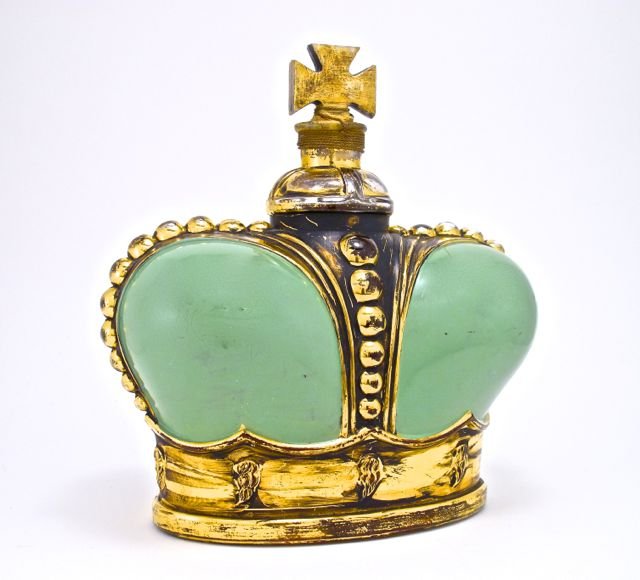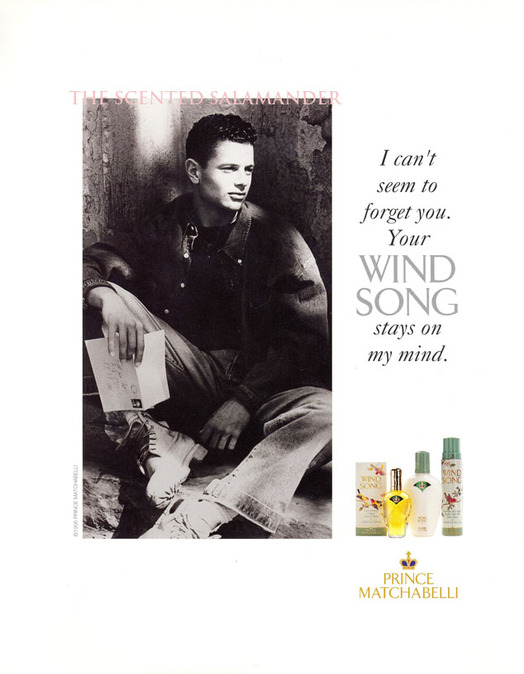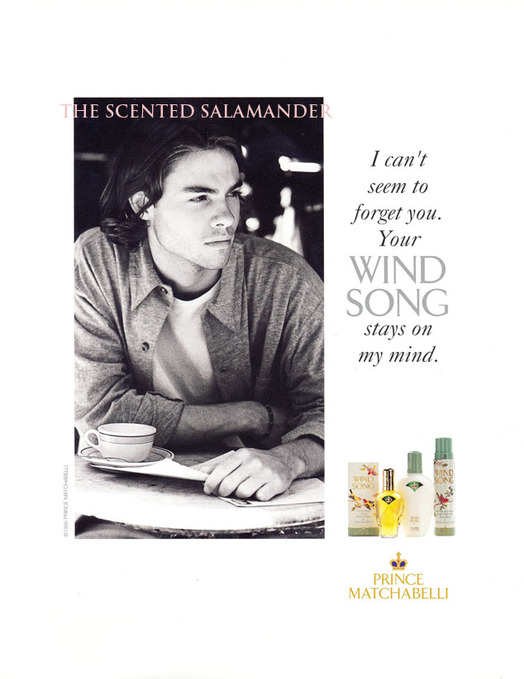Prince Matchabelli Wind Song (1953): A Perfect Fragrance {Perfume Review & Musings} & - Of The Perils of Comparing Vintage & New Formulations Side by Side {Scented Thoughts}
 "1958 Prince Matchabelli Wind Song factice size perfume bottle, gilt and enamel on clear glass, filled with perfume, sealed, bottom label, fabric pouch. 8 1/4 in. *News clipping reads: "Mrs. Vera Kieborth sniffs the 47-ounce bottle of "Wind Song" perfume which she won in a drawing sponsored by the Mabley & Carew Co. J.D. Mullally, Mabley's president, presents the bottle, one of only two in the world." Via Liveauctioneers
"1958 Prince Matchabelli Wind Song factice size perfume bottle, gilt and enamel on clear glass, filled with perfume, sealed, bottom label, fabric pouch. 8 1/4 in. *News clipping reads: "Mrs. Vera Kieborth sniffs the 47-ounce bottle of "Wind Song" perfume which she won in a drawing sponsored by the Mabley & Carew Co. J.D. Mullally, Mabley's president, presents the bottle, one of only two in the world." Via Liveauctioneers

Prince Matchabelli Wind Song by Parfums de Coeur is, no doubt in my mind right this instant - and has been for the past few days - the most perfect fragrance in the world and never has this type of preposterous, fleeting, yet sincere axiom sounded more subjectively convincing and worth a public review than in the, at times, sweltering heat of a glaring Cantabrigian summer (Note: this review was initially written, but not completed, in July 2008)...
If the latter characterization seems to diminish the very notion of a perfect scent, it does not in reality; it just expresses my genuine sense of bewilderment at finding the added, heavensent desirability of a complementarity discovered between the hotness of July in New England and the perfectly collected coolness of this subtle and fresh green powdery scent that seems to encase an elegant pin-thin-sized hand-rolled lady's clove cigarette, maculated with traces of rose-scented lipstick in its heart.
The subtle greenness is charming is what at first pulled me into the scent. I am finally not let down by the creamy, smoky and dry herbal-y vetiver in the drydown. The ylang ylang is discreetly sexy. Ah but that carnation is enigmatic and metallic yet completely alluring as a beauty with a steel prosthetic leg is: you note the silvery flash from the corner of your eye, yet quickly forget about it and are enchanted by the general aura of the person. And there is so much more to say that I will probably need to review it several times before I can let go of it.
Wind Song is, however inconspicuously, related in regard with the clove-carnation accord to perfumes like Tabu and Opium, with their central hot-and-dry carnation accords. But it is also at the same time a fresh aldehydic related to Chanel No. 5. There is something also of l'Origan in that orris chewing-gum effect. The dry woods in the base, cedar, vetiver, add a subliminal perfecting masculine touch that contributes to the sense of wholeness of the scent as in the circle of assembled yin and yang symbols. Together with the exotic suggestion offered by ylang, it comes to smell like sandalwood.
This perfume, I realize, is a hidden gem of the drugstores and the perfume world more generally speaking. It was composed by perfumer Ernest Shiftan together with Léon Harry.

A 1995 advert
For the time that I have been wearing it, my mouth has been metaphorically and sometimes almost literally left agape in stupefaction at discovering a scent that seems to have not one discernible defect in it, be it in the morning, afternoon, or night. It smells always surprisingly beautiful from whatever angle you catch it or view it. It is one of those delicate and subtle "nose-grabbers" that have you firmly and unsuspectingly on leash; they let you forget that you wear them, yet suddenly make you ask yourself in wonderment what is the heavenly smell you are sensing out of thin air different each time. And each time as in this case, it is Wind Song the Fair, the wind-rider, the well-named. Dab on a few droplets of this composition and see how the air starts to move, come alive as if the air thirsted for it. The perfume seems to waft in perfect union with ether and the scent molecules to caress and strum an invisible harpsichord.
I recognize the fact that I do not like the scent of the aromachemical Nectaryl, especially since I find it has a disfiguring, unbalanced effect in the modern formulation of Mitsouko, but its presence in Wind Song does not even succeed in breaking the spell. What could be more perfect than a subjective sense of perfection that does not yield to unfflatering detail and just leaves an overarching sensation of plenitude? Or is it that a desire for perfection informs our apprehension of a scent? We want it to be perfect and therefore it is, at times?
The chemistry between this composition and the ambient air is almost magical and incomprehensible. After a few epiphanic rediscoveries of the perfume have occurred, I catch yet another mysterious whiff and secretly pray it is the scent you are wearing, and each time, like in a perfect dream world, it is. I am stupefied by the technical and harmonic qualities of the perfume as well as by its abstraction. It does not smell of anything but visions of femininity in the 1950s at first, then going further back in time, in the 1930s. It smells of freshness, of elegance, and reveals a certain quality that I am tempted to term "douceur de vivre", la dolce vita French-style, surviving in the post-18th century world despite what Talleyrand said: "Celui qui n'a pas vécu au dix-huitième siècle avant la Révolution ne connaît pas la douceur de vivre" : ("Those who have not lived in the eighteenth century prior to the French Revolution have no idea of what the sweetness of life consist in"). It is a mix of protective motherly femininity and more seductive ostentatiousness, all set in a geographical setting like, say, a summer by the sea in Deauville in the 1920s-1930s,or perhaps right around that time when Coco Chanel opened her first store (1913) in the fashionable sea resort town in Normandy. Wind Song draws a lineage and captures the genius of a trend of olfactory embodiment of femininity that starts sometimes in those years - perhaps long before with this allusion to powdery scent - this idea of a perfume inspired by the scent of cleanliness and soap, that Chanel No. 5 was supposed to be, but makes this ideal even clearer and purer, more, again, perfect.
The fragrance, without smelling of anything like the sea and marine driftwood (I however do smell a whisper of aquatic melon) , represents this ideal sense of feeling the breeze blow from the port and the ocean lifting light and short ruffled sleeves on silken dresses worn by hatted ladies looking at the world in the half-light of a wide brim. It bespeaks of supple capelines, of white-gloved ladies cool as cucumbers, of armpits delicately powdered with talcum powder, and of a pleasant chilliness that is both of the weather and of the moral composure.
A note on Vintage Wind Song vs. Contemporary Wind Song: The Harpsichord and the Musical Saw, All In One
Another interesting experience was smelling both vintage and new versions of the perfumes side by side. The main review is based on the new version. The result turns out to be unexpected, pointless and destructive for the new, modern Wind Song. The perfect scent literally falls apart next to the old one, yet when smelled on its own regains, like a phoenix, its wonderful composure. The old, darker Wind Song retains its roundness but feels dated, heavier, grapier, less subtle than the modern Wind Song at its best.
Unbelievably so, the newish Wind Song becomes, when compared, a chemical nightmare. The perfume flacon seems to have suddenly let loose the Erynies: they are flying furiously around and screeching inchoate obscene words in my ears only stopping to play, badly, the musical saw in a metro corridor in ruin, closed since WWII and plunged into pitch-black darkness. How could such a different experience of the scent coexist with the first one and re-enacts itself? It is not like the vintage version makes me reach a higher plane of perfume comprehension. It is more like it gets in the way of a perfectly pitched illusion.
To me, it all goes to showing that before anything else, a perfume is an olfactory mirage. It deploys its beauty based on an ensemble of effects that are carefully adjusted to each other. It is a fragile equilibrium deriving from the constraint put on fine-tuning and perfection. The more you aim at perfection, not just solidity, the more all the ensemble has to stay together. An imperfect scent can be more easily layered, is more versatile, for example, than a masterpiece which stands on its own. It is a paradox and it reveals itself in the most disagreeable fashion at this point.
Secondly, a perfume uses a code. Perfume-wearers are used more or less consciously to certain smells being expressed by certain accords and molecules. These perfumery smells attempt sometimes to replicate real ones in a realistic manner, but even in these cases, they are but, fundamentally, an abstraction, a simplification of a natural smell.
Natural aromas unfold over time, are multi-faceted and therefore human intervention helps to make them simpler, clearer, stabler, in other words codified as they become also time-independent. Someone used to the natural-perfumery code will find the chemical one atrocious and vice-versa, with a whole range of hybrid experiences in between. For example, my initial reaction to a methyl ionone (viole-iris) is to think that it smells much cheaper than the older iris accords based on Iralia.
An utopian person, I have nor doubt, will upon first encountering a bottled perfume without any prior preparation probably start by hating it, be it natural or synthetic, as a gross deformation of the real-life code.
For now, I decide I will give a wide berth to the vintage version in order to enjoy the new one. But all this needs revisiting.
Notes:
Notes description commonly found on the internet: Tarragon, Coriander, Lemon, Bergamot, Lilac, Rose, Jasmine, Sandalwood, Amber, Vetiver.
Notes description from the press office of Parfums de Coeur (they had to do some research):
TOP: Sparkling Bergamot, Sheer Greens, Glistening Aldehydes
HEART: Elegant Ylang-Ylang, Velvety Rose, Silky Orris, Lush Lily of the valley
BASE: Refined Musk, Sultry Cedarwood, Sophisticated Vetiver, Soft ambers










Wonderful exploration of a particular scent and of "the comparison effect." I am, of course, enchanted and intrigued by the Wind Song you describe, and will be doing an exploration of my own ASAP.
But I am particularly intrigued by the issue of side by side comparisons. My thoughts suggest this is worth exploring both in terms of vintage vs. modern (particularly when each version is deemed "worthy" on its own), but also side by sides of moderns. I have found that certain scents that I thought I was enjoying either became different, or even disappeared, on days when I was doing "sample patches" (different scents applied to various parts of either arm). I don't know if I could make a generalization regarding when the phenomenon occurs: scents with a similar/same ingredient? similar drydowns?
Thanks so much for a fresh kind of post, and a thoughtful and thought-provoking one, as well.
Thank you -- I think that comparing two contemporary perfumes side by side can also create the same unjust relativistic approach. Edmond Roudnitska strongly disapproved of this approach saying each perfume needs to be smelled on its own. This would need some clarifying because beyond the physical experience, it remains legitimate to commit perfumes to memory and compare them this way, in my opinion.
I have experienced the same thing as you describe but also, incredibly seen in this light, perfumes that seemed to not budge an iota when smelled next to other scents, retaining all their integrity and personal universes in place.
It is indeed worth exploring further.
It's nice to hear your enjoyment !
Wind Song- old or new- is one of the more seamlessly lovely scents out there- and a bargain, at that.
It's a shame that folks feel apologetic about their pleasure; how counter-productive, and foolish.
It was always a good scent, and still is.
A classic, and very beautiful.
Windsong has always been the scent of glamor and beauty to
me.As a preteen in the 1960
era my mom's ultra feminine
divorced friend wore Windsong
...whether in a crisp
cotton sundress or a revealing cocktail number the
fragrance of beautiful Windsong floated around her.
Her name was "Van".Men adored her company.I adored
her style and scent.
Wind Song...As a pre-teen I can vividly remember sitting in science class when my teacher walked by.Her scent was intoxicating.I couldn't stop thinking about that scent,everything being said in class went out of the window,that frangrance was all I wanted to experience again. I finally asked her what she was wearing."WindSong,do you like it"? What a question.I have NEVER experienced a perfume that was so deeply emblazoned in my memory,I can remember that day exactly, That was in 1967.
I have a question that I am hoping someone can answer.When did Wind Song change their formulation and what was it that was changed?Why was the formulation changed? I can smell the difference immediately but cannot articulate what it is I am not getting from the new formulation.Because I want that 'experience' I only buy and wear the vintage perfume that comes in the beautiful gold and clear crown bottle with the cross stopper.
Another question,how can you date the crown shaped bottles? Not the large all clear ones but the gold and clear with cross top,the green and gold with cross,etc. I have tried for ages to find the answers to the above questions.PLEASE,can someone explain? Many thanks. A true devotee of vintage Wind Song ~ Laura
I really miss the original Windsong. I wish it would come back. It has been my only favorite perfume since I was 16 years old and I'm now 60. What are the chances of it coming back?